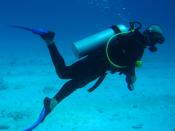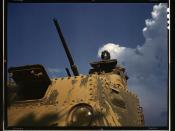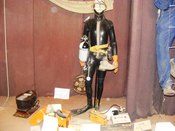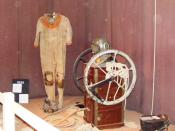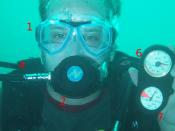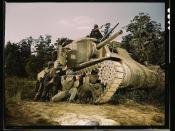Hoover, Pierce (1999) " Tanks on the Side," Sport Diver, vol. 7, no. 5, October, p. 26 While diving, especially in caverns, divers encounter very narrow horizontal openings which they must pass in order to continue in the cave system. Unhooking the tank from the B.C. and pushing it a head of you is not always the safest way to go through an opening where you don't quite fit. There is a new system that allows divers to carry tanks with them and not effect their hand availability or their vertical size. This method is called side mounting. Side mounting places the diver's tanks at the side of the body and under the arms, thus reducing the diver's front-to-back profile to less than a foot for most divers. British sump divers were among the first to perfect the side-mounting system. To reach the submerged and deep portions of a cave, known as sumps, the diver is often required to waddle or clamber over slick or jagged rock floors.
With 100 pound double sized tanks on their back this could be very dangerous. So the divers would carry the tanks through the dry portions of the cave and just attach it to their weight belt when they get to the dangerous portion of the cave. The next phase in the side-mounting history came when Americans began using side-mounted tanks to squeeze into low or narrow underwater cave passages too confined for traditional double-tank rigs. Now, a new system promises to bring side mounting into the mainstream of diving technology.
Dive Rite, a huge manufacturer of diving equipment, has developed a method of attaching tanks to the side of their popular TransPac. This is making diving easier for many cave divers, such as those with back problems. This article outlines one diver, Jim Fishback, who has back problems and cannot where double tanks. Side mounting allows Jim to carry the tanks easier to the site and just attach them in the water to the side of his B.C. It also is easier for boat divers who have to get in the water with the tanks on their backs. With the side mount these divers can get in the water, and hand the tanks down to one another.
Divers go by the rule of thirds: Always reserve a third of your air in your tank or your available breathing air for self buddy rescue. This is in case of emergency, you will have enough air to help yourself or your dive buddy. While wearing side-mounted tanks, they do not provide a single, common air supply, the rule of thirds still appies. Typically, a diver will breathe no more than a third of one tank, then switch to the alternate tank. The dive is turned or over when both tanks are at least two-thirds full, allowing enough reserve gas for delays or for buddy rescue. A plus of side mounting, is that, instead of buddy breathing, or sharing a regulator, with your partner in an emergency, you can just give your buddy another tank from your side. This is safer when the divers are deep in a cave system. Instead of worrying about getting out and worrying about a buddy sharing a reg. and tank, a diver can just worry about getting out and know his partner has his own tank. This system not only simplifies air sharing, but the use of separate tanks may also lessen the impact of certain types of equipment failures and will preserve adequate reserve gas even in the event of total regulator or valve failure.
In conclusion, the side-mount is a old technique in diving that is making a impression on many of the divers in today's dive community.
